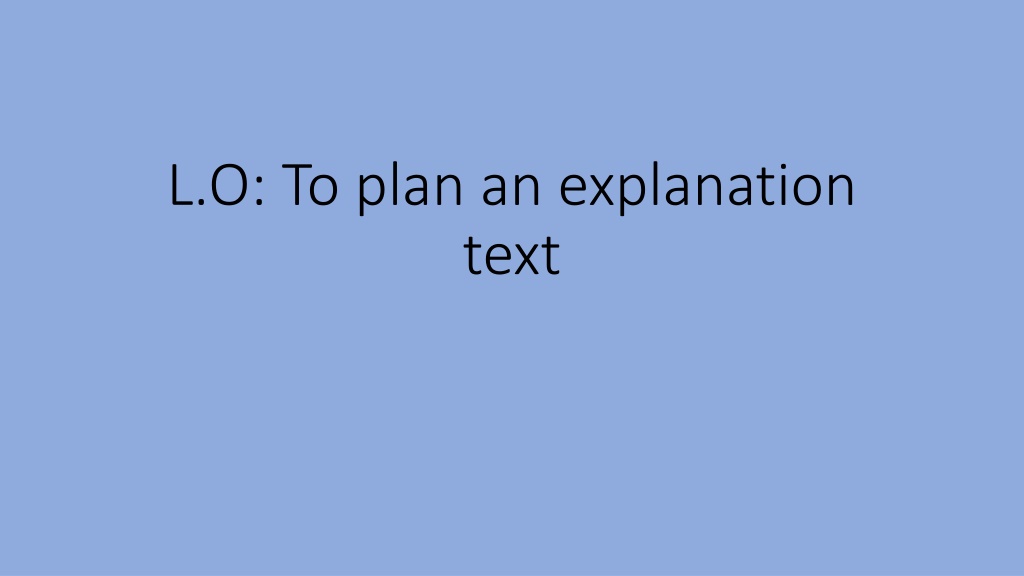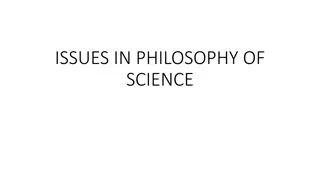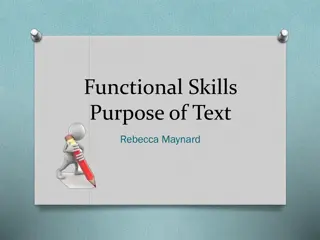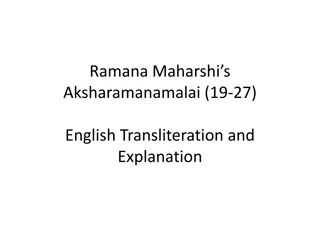Creating an Effective Explanation Text Plan
Crafting a comprehensive explanation text involves specific features such as present tense, formal language, numbered points, sub-headings, time connectives, technical vocabulary, glossary, diagrams, and pictures. By following a structured plan with subheadings like Title, Introduction, Main body of text, Conclusion, and Technical language, one can effectively convey information. In this task, we outline a plan for explaining how to change a television channel using the Tellyscope 2000, emphasizing detailed explanations and the strategic use of technical terms and conjunctions.
Download Presentation

Please find below an Image/Link to download the presentation.
The content on the website is provided AS IS for your information and personal use only. It may not be sold, licensed, or shared on other websites without obtaining consent from the author.If you encounter any issues during the download, it is possible that the publisher has removed the file from their server.
You are allowed to download the files provided on this website for personal or commercial use, subject to the condition that they are used lawfully. All files are the property of their respective owners.
The content on the website is provided AS IS for your information and personal use only. It may not be sold, licensed, or shared on other websites without obtaining consent from the author.
E N D
Presentation Transcript
Features of explanation texts: Written in the present tense, in formal language Text arranged into numbered points Sub-headings to separate sections of text Time connectives, such as: first, then, next, later, finally. Technical vocabulary (sometimes in bold), for example: if the text is about how a car is made, it may include words such as 'ignition', 'engine' and 'bonnet' Glossary to explain technical vocabulary Diagrams with labels Pictures with captions
Today we are going to plan our explanation texts using our flowcharts to help us
Following that, the tennis ball will shoot through a hole in the wall and make its way through a series of pipes. First, press the red button on the sofa arm and as a result the metal hand containing a tennis ball will appear. Pull back the hand and release. As a result, the tennis ball will be fired towards the wall. Then, it will turn some gears in the mechanism behind the wall, which consequently will move the television forward. Finally, as the television moves towards you, hold your finger out so that you can press the channel change button. The television will then return to it s original position. Warning: This machine does not always work. Word Bank Therefore, Consequently, Because, As a result of this, Following, So, If
Set your plan out using the following subheadings: Title Introduction Main body of text Conclusion Technical language
Make brief notes and bullet points to plan your explanation text Title (does this clearly show what you are explaining?): How to change your television channel using the Tellyscope 2000 . Introduction (How will you introduce your explanation text?) Start with a rhetorical question, explain how my machine can help solve a problem, explain how it will change people s lives.
Main body of text (full explanation of how machine works) Include detailed explanation of what you have to do to make the machine work and how it functions. Use a range of technical language here and make sure you have included causal and time conjunctions
Conclusion Explain how this machine will change people s lives. What to do if the machine does not work or is faulty. Technical vocabulary Make a list of the technical language you are going to include.
You are planning your text today, do not write out the whole text. Write your plan using the 5 headings from the previous slides. Under each heading, make brief notes about what you are going to include . Use your flowchart and your drawing of your contraption to help you. Use the example explanation texts on the next slides for support.
The water cycle The water cycle is also known as the hydrological cycle. There is the same amount of water on the Earth now as there was when the Earth began. The water cycle is how the earth's water recycles itself. The cycle includes precipitation, evaporation, condensation, and transpiration. Earth's water keeps changing from liquid water to vapour and then back again. This cycle happens because of the sun's heat and gravity. How does the Water Cycle work? 1. First of all, water molecules from lakes, rivers, streams, reservoirs, and the sea get heated up by the sun and then turn into vapour that rises into the air. 2. Next, these water molecules form into clouds, this is because a process called condensation occurs. 3. When the air and the water cool, they form drops of water which then fall to the earth as rain. If they are frozen, they become snow or sleet. 4. Once the water reaches the ground, it can flow across the land until it reaches rivers, lakes, streams, or the sea. It can also sink into the ground and flow because of gravity through gaps in rock, gravel and sand. Because of this, it reaches these bodies of water too. 5. Now the cycle begins again, when water is evaporated once more. Why is water important? Many of us think water will always be there for us when we want it. Without water, living things would die. You will die if you go without water for more than a week. Plants will die without water and that would kill all of the animals that eat the plants.
How to Fly a Hot Air Balloon A hot air balloon consists of a basket, four big gas tanks, a burner and the balloon or envelope . First, the pilot puts four nylon poles into sockets on top of the basket. Then she puts the burner on top of the poles. Next, she connects the cables to the burner frame. The cables also go under the basket in order to hold everything together. After this, she connects the hoses from the full gas tanks to the burner so that she can test it. Next, two people hold the mouth of the balloon open while it is filled with cold air from the fan until it is quite fat and tight. Now for the difficult bit. The pilot lies on the ground, half in the basket. She turns on the gas burner and points the flame into the mouth of the balloon. This is so that the balloon slowly stands up. When the pilot is ready to go, she heats up the air in the balloon a bit more. This results in the air in the balloon to be hot enough to get the balloon to rise off the ground.























